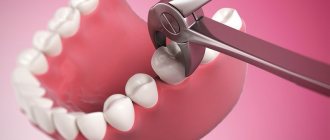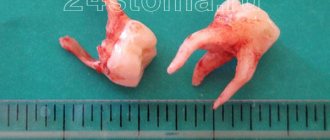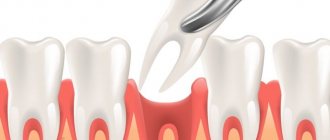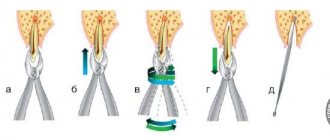Dear friends, last time we talked about what wisdom teeth are like, when they need to be removed and when not. And today I will tell you in detail and in every detail how the removal of “sentenced” teeth actually takes place. With pictures. Therefore, I recommend that especially impressionable people and pregnant women press the “Ctrl +” key combination. Joke.
Where does the removal of the 8th, and, in principle, any other tooth begin?
With anesthesia.
So:
What types of pain relief are used during tooth extraction?
A classic example of an archaic tooth extraction without any anesthesia is an episode from Chekhov’s story “Surgery.” In modern dentistry, such outright torture does not happen, and tooth extraction without anesthesia is not carried out under any circumstances. If it is necessary to remove 1 - 2 teeth in one visit, the operation is carried out mainly under local anesthesia. However, there are indications for tooth extraction under general anesthesia.
In medicine, the term “general anesthesia” means a state of inhibition of the central nervous system with a temporary immersion of the patient into sleep of varying degrees of depth and loss of pain sensitivity. This reaction of the body is artificially induced using safe anesthetic medications, and it lasts from 30 minutes to 3 hours, depending on the required volume of surgical intervention. For example, removing 4 wisdom teeth under general anesthesia will require a significant amount of time.
Content:
- Options for local anesthesia of a diseased tooth 1.1. Application 1.2. Infiltration 1.3. Conductor 1.4. Intraosseous 1.5. Intraligamentary
- Contraindications
- Pros and cons of local anesthesia in dentistry
To ensure that tooth extraction takes place with maximum comfort for the patient and is not associated with pain, dentists use special painkillers.
If the case is very complex and local anesthetics do not cope, anesthesia is used. Painkillers used in dentistry block the transmission of nerve impulses from the torn unit to the brain. Due to this, all manipulations carried out by a specialist are calmly perceived by a person.
Advantages of tooth extraction under general anesthesia
- Anesthesia slows down the body's reactions, due to which the pain is completely relieved. Therefore, all the dentist’s procedures for removing teeth will be completely painless for you.
- Many sensitive patients put off visiting a surgeon until dangerous complications develop simply because they are afraid of the mere sight of surgical instruments. If teeth are removed under general anesthesia, you will not see how the process will occur, but will only wake up when it is over.
- Even for a psychologically stable person, tooth extraction is a stressful situation that negatively affects the body. For example, patients often experience increased blood pressure during this procedure. However, if the operation is performed under general anesthesia, your nerves will not be damaged.
- While the anesthesia is in effect, the dentist will remove the necessary teeth and perform the necessary manipulations, which could take several visits. He will perform all actions carefully and efficiently, which will reduce the risk of complications.
Interesting fact!
According to data from various media sources, at least 2% of adults and 6 - 8% of children, for various reasons, do not have the opportunity to undergo routine tooth extraction using local anesthesia.
Maxillofacial surgeon - Ph.D. Serpukhovitin Vladislav Sergeevich
Chief dental surgeon, doctor of the highest category. One of the most famous maxillofacial surgeons in Moscow. He is a full member of the Society of Oral and Maxillofacial Surgeons.
To remove the most complex teeth, an ultrasonic device (piezo scalpel) is used, which destroys tooth tissue without affecting the gums and bone. Vladislav Sergeevich can easily remove even the tooth that is located next to the nerve.
Installed more than 20,000 implants. Proficient in all the latest implantation techniques with various systems, as well as various methods of bone tissue augmentation, including the use of membranes, bone blocks and sinus lifting
Types of anesthesia for tooth extraction and methods of its behavior
Based on the depth of anesthesia, anesthesia is divided into the following types:
- surface;
- easy;
- full;
- super deep.
For dental treatment under anesthesia, only superficial and light anesthesia is used in dentistry. While the last two types are used for complex operations, for example, for maxillofacial injuries.
Anesthesia is carried out in two main ways:
- inhalation - you inhale sprayed particles of the drug through a special mask;
- intravenously - using a regular injection.
High-quality anesthetic drugs promote restful drug-induced sleep and recovery from it without any complications. Modern anesthetic medications are highly safe and suitable even for patients with allergies. They do not cause side effects or addiction and are easily eliminated from the body.
List of indications for treatment under sedation
When can you use sedation and who is it suitable for?
As for children, not all children can be treated with sedation. These are usually older children, usually over 5-6 years of age, who may have contact with a dentist and may even allow an oral examination. But as far as treatment is concerned, there is a fear of procedures and lack of perseverance. Such children can be offered nitrous oxide sedation. It has a weak analgesic effect and causes a state of mild euphoria, or mild intoxication, which in some cases allows for minor dental treatment.
In adults, it is also possible to use nitrous oxide sedation if the level of anxiety is minimal. For patients with more severe dental phobia, intravenous sedation is used, which allows one to achieve a certain degree of depth of sedation with the possibility of changing the level during treatment. Thus, the treatment becomes comfortable not only for the patient, but also for the dentist.
Indications and contraindications
The use of anesthesia in each specific case must have serious medical reasons, so it is used infrequently. In addition, the cost of tooth extraction under general anesthesia is quite high. If you are simply afraid of surgery, but you only need to remove one front tooth, then in this case it is advisable to use light sedatives and carry out tooth extraction under local anesthesia. If the surgeon’s task is much more complex and the volume of work is large, then general anesthesia is appropriate.
Indications
The following main indications exist for the use of general anesthesia during tooth extraction:
- allergy to local anesthetics;
- panic fear of treatment;
- increased blood pressure (hypertension) due to stress;
- a gag reflex in the patient, which prevents the doctor from performing the operation;
- large volume of manipulations;
- inability of a patient with disabilities to sit in the dental chair.
Contraindications
Speaking about contraindications to tooth extraction under general anesthesia, you should be guided by the list of factors presented below that may cause refusal of this procedure:
- exacerbation of chronic pathologies;
- diabetes mellitus in the stage of decompensation;
- acute heart failure;
- period up to six months after myocardial infarction;
- heart defects;
- infectious diseases;
- anemia;
- epilepsy;
- pathologies of the respiratory system.
Premedications
- Sedatives of plant origin (Corvalol, tinctures of motherwort and valerian). Necessary to reduce excitability.
- Neuroleptics (droperidine).
- Anticholinergic drugs.
- Opioid drugs (promedol and morphine).
The selection of the listed drugs is made by the attending physician, based on the specific situation and individual characteristics of the small patient. There must be a compelling reason to use general anesthesia in children.
When is tooth extraction required under anesthesia?
Complex tooth root removal
The lateral (chewing) teeth have a complex root system. Sometimes it takes quite a long time to extract them. Removing a tooth root under anesthesia allows the surgeon to carry out a large amount of work during one patient visit.
Removal of impacted wisdom tooth
One of the most difficult operations is the removal of a wisdom tooth under general anesthesia. The roots of “eights” are often irregular, intertwined with each other, and go under the adjacent tooth. Resection of unerupted (impacted) wisdom teeth is especially difficult. They have to be removed for a long time and carefully through incisions in the gums. That is why 8 teeth are removed under general anesthesia.
Removal of several molars
When it is necessary to remove several molars during one visit to the dentist, it is also advisable to use general anesthesia. Often, the doctor performs additional manipulations of gum plastic surgery with bone grafting if subsequent installation of implants is planned.
Indications for removal
Medical indications can be divided into 4 main groups.
- Crowding of teeth When even one figure eight erupts in the dentition, crowding occurs in 8 cases out of 10, and promises dire consequences. At contact points, i.e. between teeth, hygiene is compromised, and caries forms. Tooth displacement leads to gum recession and bone loss, especially in the anterior region. Pathology leads to the loss of up to 10 teeth by the age of 40.
- Destruction of wisdom teeth The inaccessibility of the eighth teeth to a toothbrush leads to a natural result - first caries develops, then pulpitis and acute pain. Treatment in advanced cases is not far-sighted, because the probability of relapse is too high, and such a tooth is already useless for future hypothetical prosthetics. Removal is more efficient and cheaper.
- Growing difficulties The eruption of eights is not “prepared” by the pioneer milk teeth. That is why the process of their birth is painful and navigationally unpredictable. Wisdom teeth destroy the roots or crowns of the 7th teeth, grow into the cheek, and compress the trigeminal nerve.
- Orthodontic preparation It is almost always impossible to straighten teeth and form a healthy bite using braces or aligners without removing figure eights - there is not enough space for teeth to move. Orthodontic referral is the most common reason for immediate removal.
How to remove – one at a time or “in bulk”? It is important to understand that from a medical point of view, there is absolutely no reason for the patient to remove wisdom teeth one by one.
Stages of tooth extraction under general anesthesia
Preparation
Questions about the choice of anesthetic and the method of its administration are resolved individually for each patient. To do this, the anesthesiologist will collect an anamnesis, inquire about the patient’s chronic diseases and refer him to diagnostic procedures (usually a blood test and an ECG). It is also necessary to consult with a neurologist, therapist and otolaryngologist in order to identify contraindications to the use of general anesthesia.
Operation
Literally one minute after the administration of the anesthetic by inhalation or intravenous route, the patient feels drowsy and gradually falls asleep. Within five minutes, his breathing stabilizes and his muscles relax. During a tooth extraction operation under general anesthesia, a qualified anesthesiologist is constantly with the patient, monitoring his vital signs: pulse, blood pressure, body temperature, skin tone, blood circulation and ventilation.
Coming out of anesthesia
The doctor calculates the dose of the anesthetic so that its effect ends 10 - 20 minutes after completion of all manipulations. The patient gradually wakes up, and after 60 - 90 minutes his state of health is completely stabilized. After this, he can go home, but for this he will need an accompanying person. In addition, after tooth extraction under general anesthesia, you should never drive!
When preparing for tooth extraction under anesthesia, be sure to inform your doctor about all medications you are currently taking. Six hours before surgery you should stop eating and stop smoking. Stop drinking any drinks, including plain water, at least four hours before surgery.
General anesthesia (narcosis) and sedation: concepts
General anesthesia (general anesthesia, anesthesia) is a type of general anesthesia in which sensitivity and consciousness are completely turned off by introducing a person into a state of deep medicated sleep. Anesthesia can be inhalational (anesthetic is supplied into the respiratory tract through a laryngeal mask or endotracheal tube) or intravenous (anesthetic is supplied into a vein).
There are situations when the patient does not need to turn off consciousness completely, then we can talk about sedation from deep to very light - superficial.
Sedation is a state of drug influence in which one or another level of consciousness is maintained. At the same time, protective reflexes are preserved, there is no anxiety or discomfort, and the patient experiences a feeling of relaxation and calm. The patient may practically not react to the doctor’s actions, since he is simply sleeping, therefore, he does not care about everything that happens around him. Although, for some people, the dosage of the anesthetic drug is calculated in such a way that he can hear the doctor’s voice and perform simple actions, for example, raising his head higher, opening his mouth wider, etc.









